| Columns Retired Columns & Blogs |
Love theme from the movie 'Romeo and Juliet' ............ Nino Rota :-) .........
Arthur Fiedler & Boston Pops Orchestra :-) .............
Henry Mancini :-) ............
Andre Rieu :-) .............
I measured one of the Cary CAD-805RS amplifiers (serial no. 180218) using my Audio Precision SYS2722 system (see the January 2008 "As We See It"). Before doing so, I installed all the tubes, following the guide in the manual, and checked that the bias current for the 300B driver tube was the recommended 60mA, using the front-panel meter. I checked the bias current several times while performing the measurements, but it hadn't changed. I took complete sets of measurements from the 4, 8, and 16 ohm output-transformer taps with the 845 output tube that AD preferred, and with the negative feedback set to 0, 5, and 10dB. I repeated some of the tests using the 211 output tube.
The Cary's impedance measured a usefully high 55k ohms at 20Hz and 59k ohms at 1kHz, and was still 51k ohms at 20kHz. The three outputs all preserved absolute polarity (ie, were non-inverting). The CAD-805RS's clipping power, voltage gain, and output impedance all varied with signal frequency, the output transformer tap, the output tube, and the level of negative feedback selected. The voltage gain at 1kHz was highest from the 16 ohm tap with the 211 output tube and zero feedback, at 21.75dB; it was lowest from the 4 ohm tap with the 845 tube and 10dB of feedback, at 14.85dB. In general, increasing the feedback from 0 to 5dB reduced the gain by around 0.35dB; the 10dB setting reduced the gain by another 2–2.5dB. Art's preferred setting of the 8 ohm tap with 6dB of feedback gave a gain of 19.5dB.
As expected, the CAD-805RS's output impedance was lowest from the 4 ohm tap, with 10dB of negative feedback at 0.61 ohm with the 845 tube, and 0.71 ohm with the 211 tube, both measured at 1kHz. Reducing the feedback to 5dB increased these impedances to 0.78 and 1 ohm; the 0dB setting increased these further, to 0.85 and 1.1 ohms. The impedance with 5dB of feedback from the 8 ohm tap at 1kHz was 1.4 ohms with the 845 tube, 1.86 ohms with the 211. The impedances from the 16 ohm tap with 5dB of feedback were 2.8 and 3.7 ohms. The highest output impedance with the 845 tube was 3.3 ohms at 20Hz from the 16 ohm tap with 10dB of feedback—still relatively low for a single-ended triode amplifier.
The modulation of the Cary's frequency response with the 4 ohm tap driving our standard simulated loudspeaker, with the 211 tube and 10dB of feedback, was a fairly low ±0.5dB (fig.1, gray trace). The output rolled off rapidly above 20kHz, and a boost of up to 3dB, depending on the load impedance, can be seen in the low bass. The behavior was very similar with the 845 tube (fig.2), again measured from the 4 ohm tap with 10dB of negative feedback, but the low-bass boost is smaller. The same ultrasonic peak from the output transformer can still be seen, however, more fully developed into higher impedances. The peak was lowest in level from the 16 ohm tap with no feedback (fig.3), but the audioband response modulation was now a very audible ±1.7dB. The ultrasonic peak gave rise to some critically damped overshoot with a 10kHz squarewave (fig.4). A 1kHz squarewave (fig.5) was superbly square, a tribute to the output transformer.
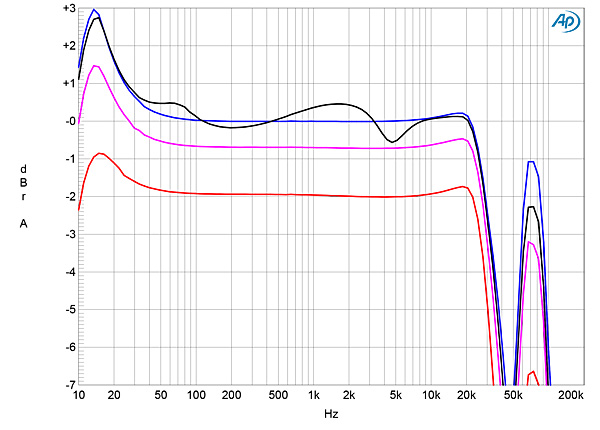
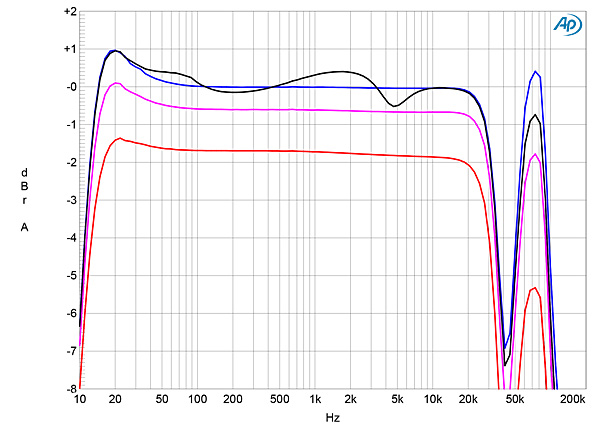
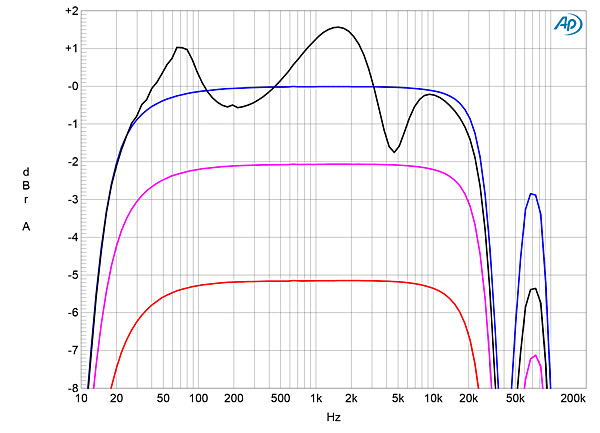
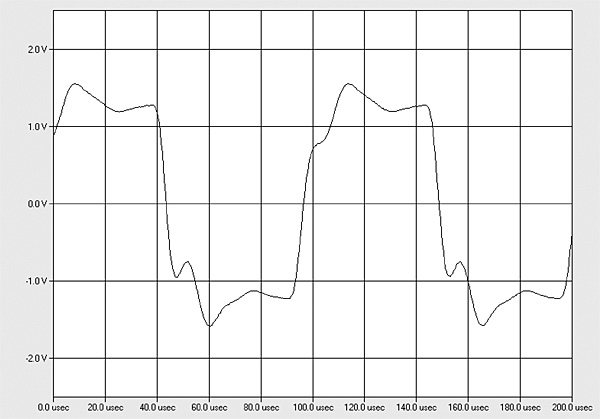
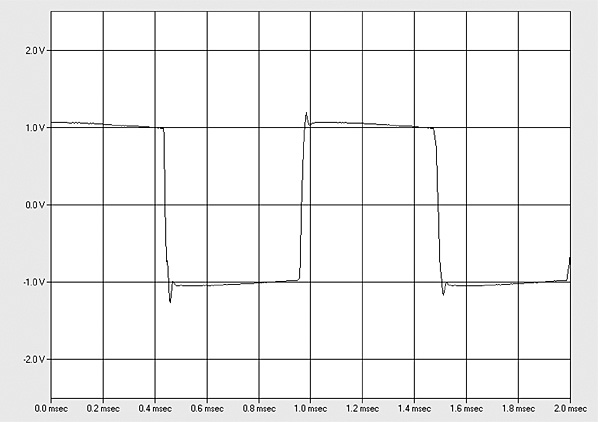
AD mentioned hearing a slight amount of hum; spectral analysis of the low-frequency noise floor (fig.6) showed that a power-supply–related spurious tone at 60Hz lay at –70dB ref. 1W from the 8 ohm tap into 8 ohms, and though higher-order supply harmonics are present, these are all much lower in level. The unweighted, wideband signal/noise ratio, taken with the 845 tube, the inputs shorted to ground, and no negative feedback, was a good 66dB from the 4 ohm tap, decreasing to 62.1dB from the 16 ohm tap. Applying 10dB of negative feedback increased these S/N ratios by 2dB, while an A-weighting filter in circuit gave a further improvement of up to 20dB.
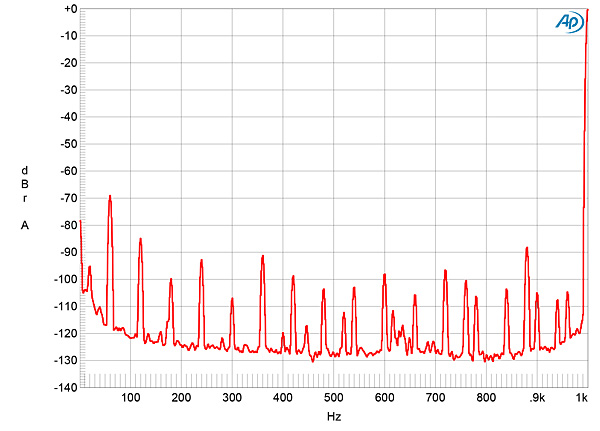
Cary specifies the CAD-805RS as offering a maximum power of 27W in class-A (14.3dBW into 8 ohms) and 50W in class-A2 (17dBW into 8 ohms). Defining clipping as when the THD+noise in the output reaches 1%, my measurements of the CAD-805RS's clipping power were lower than this. For example, fig.7 shows how the THD+N increases with power into an 8 ohm load, with the 845 tube and 10dB of feedback. The THD+N rises linearly, reaching 1% at 7.3W (8.6dBW) and 3% at 31W (14.9dBW).

Less power was available from the 4 ohm tap into 4 ohms (fig.8): 2.1W at 1% THD+N (2.1dBW) and 13W at 3% (8.3dBW). As I would expect, without negative feedback the THD+N percentage was higher at low powers (fig.9), with less power available at clipping: 4.2W (6.3dBW) at 1% THD+N and 10W (12.8dBW) at 3%.
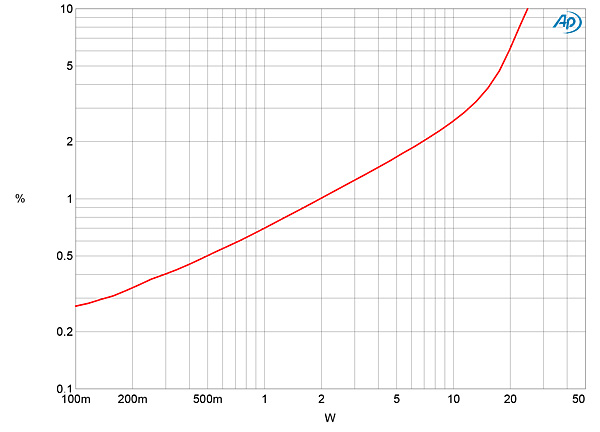

The 211 tube gave the highest power from the 4 ohm tap into 8 ohms with 10dB of feedback (fig.10), 4.4W being available at 1% THD+N (6.4dBW) and 26W at 3% THD+N (14.15dBW). In general, the Cary amplifier offers the most power into loads that are higher than the nominal transformer-tap impedance and with the highest amount of feedback.
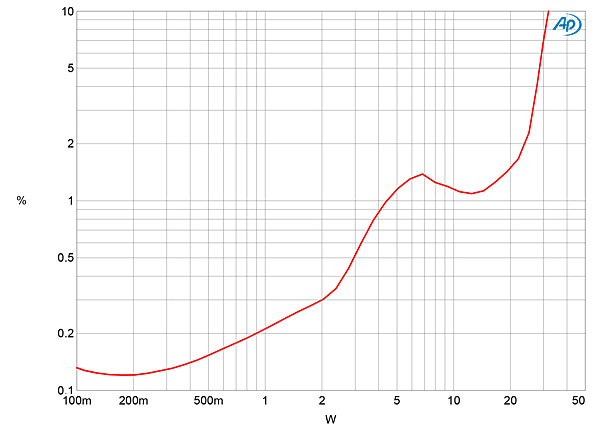
I then examined how the CAD-805RS's percentage of THD+N from the 8 ohm tap, with the 845 tube and 10dB of feedback, varied with frequency at 2.83V (equivalent to 0.5W into 16 ohms, 1W into 8 ohms, 2W into 4 ohms, and 4W into 2 ohms). The distortion was lowest in the upper midrange and low mid-treble into 16 ohms (fig.11, gray trace), and remained well below 1% into 8 ohms (blue trace) and 4 ohms (magenta). The THD+N rose a little in the top two octaves but considerably more in the bass, this due to saturation of the output transformer's core. Eliminating negative feedback but otherwise keeping everything the same doubled the level of THD+N in the midrange and treble (fig.12), but not at the extremes of the audioband. Replacing the 845 tube with the 211 gave THD+N vs frequency curves with similar shapes, but much higher distortion into low impedances (fig.13).
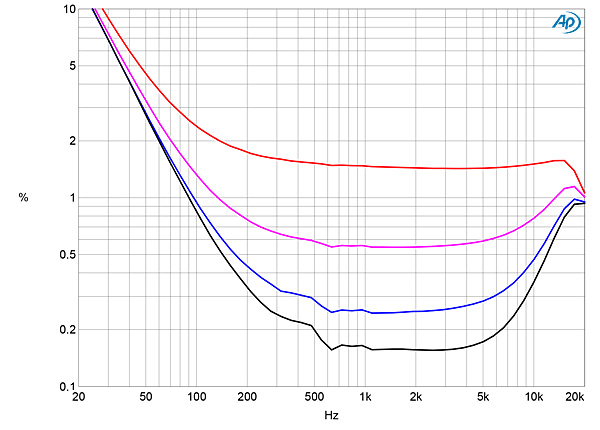
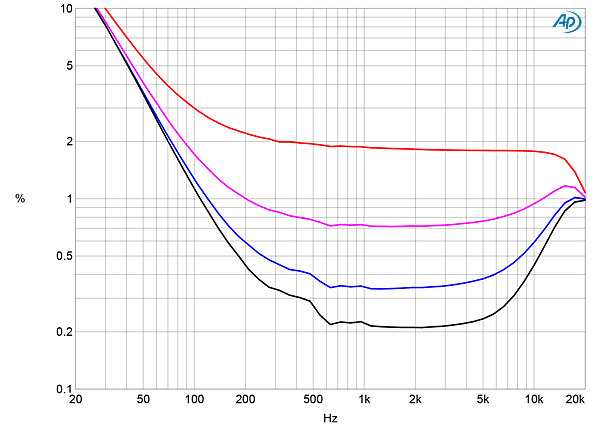
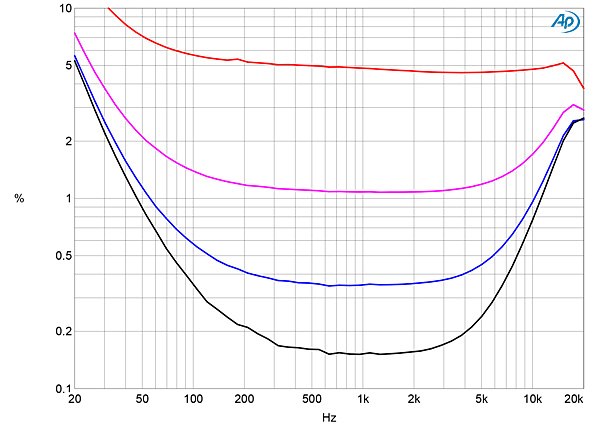
While in absolute terms the CAD-805RS produced relatively high levels of distortion even at low powers, its distortion signature was predominantly the subjectively benign second harmonic, which is consonant with music, comprising tones an octave higher than every spectral component (fig.14). This remained the case at low frequencies, though the third, fourth, and fifth harmonics made appearances, albeit at lower levels (fig.15). This graph was taken with AD's preferred conditions, the 845 tube and 8 ohm transformer tap with 6dB of negative feedback. Replacing the 845 with the 211 tube gave slightly lower levels of second-harmonic distortion (fig.16). With an equal mix of 19 and 20kHz tones and the signal peaking at 1Wpc into 8 ohms from the 8 ohm tap, with the 845 tube and 6dB of feedback, the second-order difference product at 1kHz was at an audible –40dB (1%) (fig.17), though higher-order products were much lower in level.
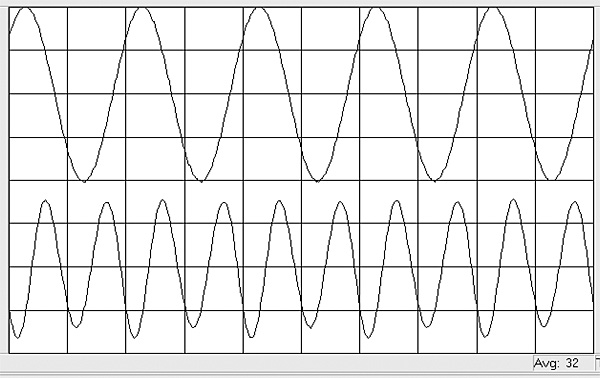
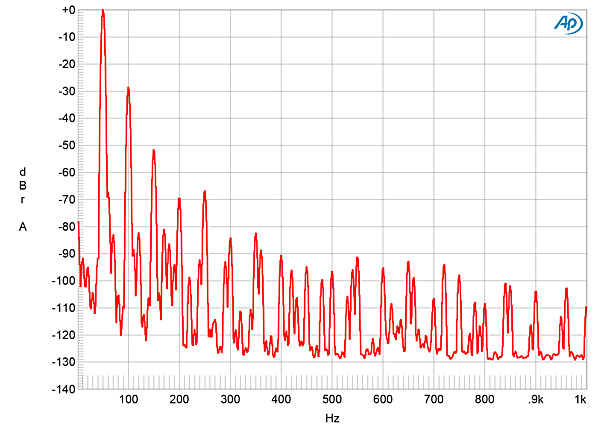
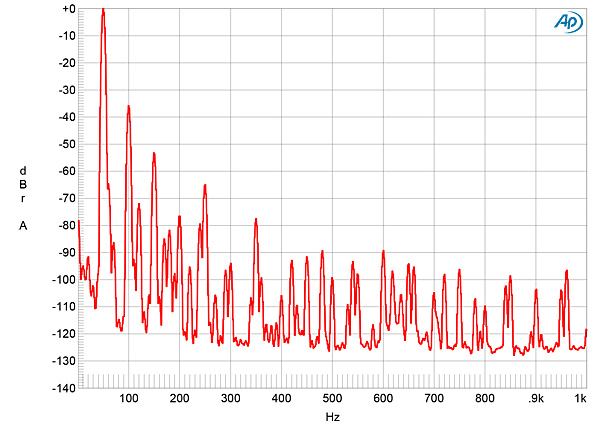
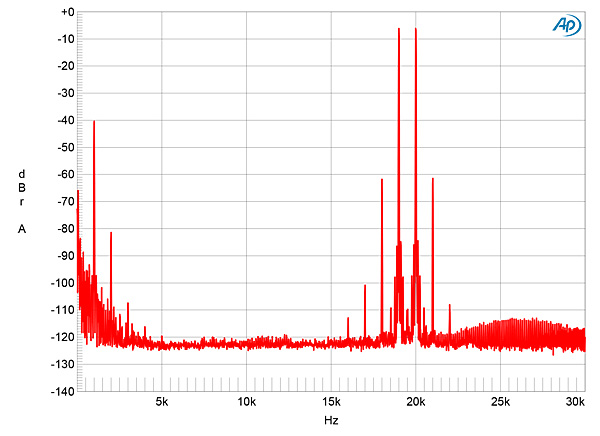
The measured performance of Cary Audio's CAD-805RS was pretty much what I'd expected from a tube design using a single-ended triode as its output stage (see As We See It"). But it does suggest that the big Cary will give of its best with high-impedance, high-sensitivity speakers, such as the DeVore Fidelity Orangutan O/93s AD used for his listening.—John Atkinson

Love theme from the movie 'Romeo and Juliet' ............ Nino Rota :-) .........
Arthur Fiedler & Boston Pops Orchestra :-) .............
Henry Mancini :-) ............
Andre Rieu :-) .............

"I Was Made for Lovin' You" baby ......... Kiss :-) ............

These are old Dennis Had designs. They were great amps and a bit noisy. Surprised that small improvements weren't made in the years since Had left assuming the company intended to go back to their roots. The AES Six Pacs had to be the best value monoblocks to have ever been produced. I still have a pair in a closet somewhere with an SLP98 pre.

May be AD or JA could review the Carver Crimson/Raven 350 tube mono-bloc amps ($10,000) for comparison? ...... They are rated 350 WPC :-) ...........

This amp looks good without the protective net, but boring with the net on. The price (you can get a decent used car for this much money) and the measured THD are astronomical. In sum, a perfect toy for audiophiles swimming in money.